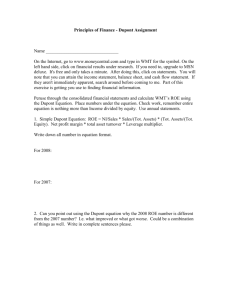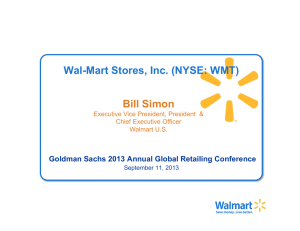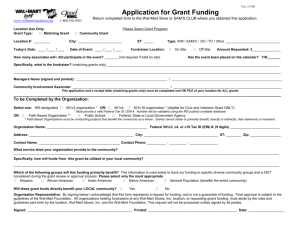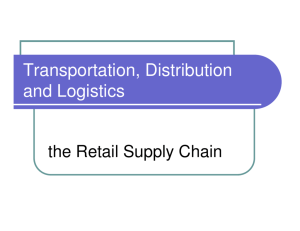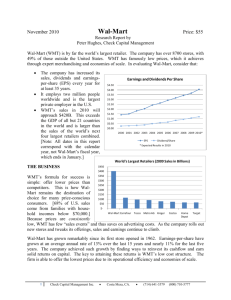Wal-Mart's Environmental Strategy - Center for Sustainable Global
advertisement
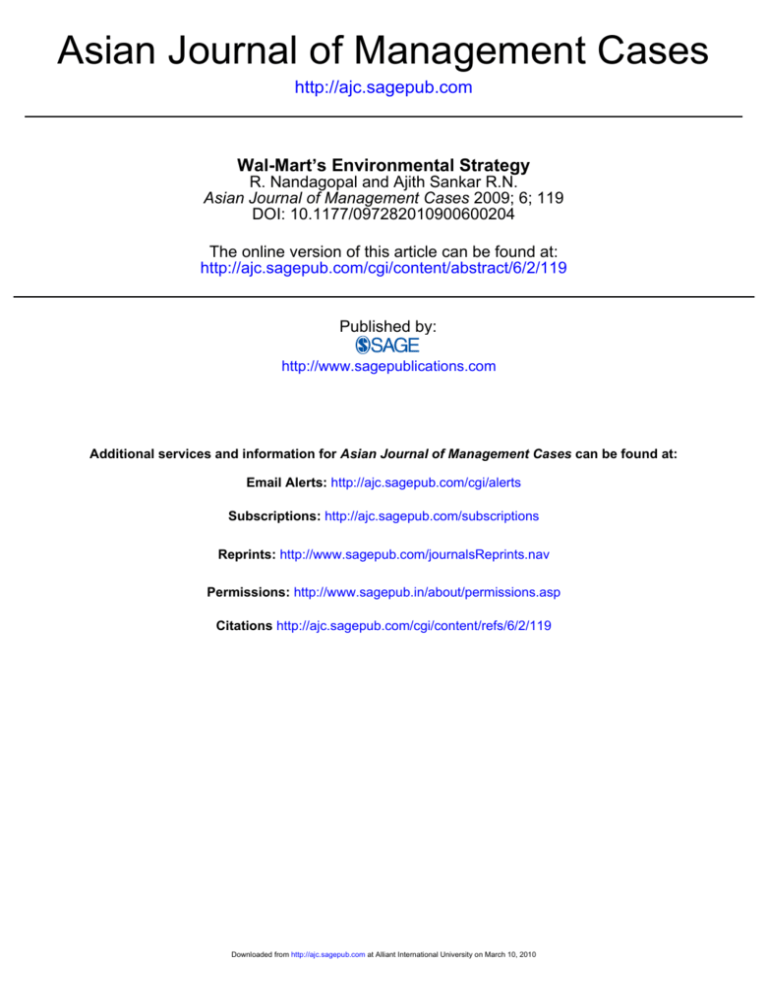
Asian Journal of Management Cases http://ajc.sagepub.com Wal-Mart’s Environmental Strategy R. Nandagopal and Ajith Sankar R.N. Asian Journal of Management Cases 2009; 6; 119 DOI: 10.1177/097282010900600204 The online version of this article can be found at: http://ajc.sagepub.com/cgi/content/abstract/6/2/119 Published by: http://www.sagepublications.com Additional services and information for Asian Journal of Management Cases can be found at: Email Alerts: http://ajc.sagepub.com/cgi/alerts Subscriptions: http://ajc.sagepub.com/subscriptions Reprints: http://www.sagepub.com/journalsReprints.nav Permissions: http://www.sagepub.in/about/permissions.asp Citations http://ajc.sagepub.com/cgi/content/refs/6/2/119 Downloaded from http://ajc.sagepub.com at Alliant International University on March 10, 2010 ASIAN JOURNAL OF MANAGEMENT CASES, 6(2), 2009: 119–133 SAGE PUBLICATIONS LOS ANGELES/LONDON/NEW DELHI/SINGAPORE/WASHINGTON DC DOI: 10.1177/097282010900600204 WAL-MART’S ENVIRONMENTAL STRATEGY R. Nandagopal Ajith Sankar R.N. The case looks into the evolution of environmental strategy at Wal-Mart. From being an organization that was the target of extensive public criticism due to a number of its corporate policies, Wal-Mart emerged as one of the most talked about green organizations of the world. The case tries to explain the green initiatives undertaken by the company that resulted in the company gaining acclaim. The case explains the impact of Wal-Mart’s green strategy and also factors like leadership and strategy alignment that contributed to its success. Keywords: Green strategy, environmental strategy, corporate strategy, business strategy, cost strategy, environment, green washing, waste, supply chain management, value networks, sustainable development, sustainability. I firmly believe that a company that cheats on overtime and on the age of its labour, that dumps its scraps and chemicals in our rivers, that does not pay its taxes or honour its contracts—will ultimately cheat on the quality of its products. And cheating on the quality of products is the same as cheating on customers. We will not tolerate that at Wal-Mart.1 Lee Scott, Former President and CEO, Wal-Mart Stores, Inc. Wal-Mart Stores, Inc. (NYSE: WMT), the leading company in the Fortune 500 list for 20082 operated 4,253 retail units in the United States and 3,355 retails units internationally.3 The company, known for its low cost retailing strategies, operated in fourteen countries 1 Announced at the Global Responsible Sourcing Initiative Summit at Beijing, China, 22 October 2008. The Fortune 500 is an annual list compiled and published by Fortune magazine that ranks the top 500 U.S. public corporations as measured by their gross revenue. 3 As of December 2008. 2 This case was written by Dr Nandagopal, Director, PSG Institute of Management, India and Ajith Sankar R.N., Lecturer, PSG Institute of Management, India. Downloaded from http://ajc.sagepub.com at Alliant International University on March 10, 2010 ASIAN JOURNAL OF MANAGEMENT CASES, 6(2), 2009: 119–133 and served more than 100 million customers. Globally, the company was also one of the largest private employers. A megalith corporation like WMT created substantially large ecological footprints. Taking into consideration the influence WMT wielded and also the scale of its operations, WMT’s decision to go green, as announced by Lee Scott (Scott), Former Chief Executive, WMT was initially met with skepticism from the public. However, its persistence on initiating and implementing ecologically friendly business processes seemed to have paid off. The company made cost savings through such initiatives and was projected as one of the leading green companies by the media. WMT also found that doing the right thing resulted in improved employee morale. While cost savings had been projected as the carrot for going green, observers questioned, to what extent this theme could be used as sales pitch for embracing green initiatives. Americus Reed, Marketing Professor at the Wharton School of Business said, ‘The barrier to proliferation of socially responsible policies is that it’s difficult to show social goodwill on the balance sheet. There is no column or item to say, “Here it is, here are the savings in dollars”. That’s the conundrum’. COMPANY HISTORY Sam Walton (Walton) started WMT in 1962 by opening the first store in Rogers, Arkansas, USA. The company went public in 1972 and with the infusion of funds, it grew to 276 stores by the end of the 1970s. In 1980, the sales revenue touched USD one billion. Exhibit 1 illustrates the operating results for WMT in recent years. Walton was focused on offering the lowest possible prices to his customers. He said, ‘If we work together, we’ll lower the cost of living for everyone… We’ll give the world an opportunity to see what it’s like to save and have a better life’.4 This statement was considered to be Wal-Mart’s mission. In alignment with this philosophy, the company had been using the tagline ‘Always low prices’. In September 2007, WMT changed its tagline to ‘Save Money, Live Better’. The new mission of the organization ‘is to help people save money so they can live better’. The culture of WMT was threaded to its three basic beliefs—‘Respect for the individual’, ‘Service to our customers’ and ‘Striving for excellence’. The values that the company adhered to (see Exhibit 2), were built on these belief systems. 4 See http://walmartstores.com/AboutUs/8123.aspx (Accessed on 4 November 2009). 120 R. NANDAGOPAL AND AJITH SANKAR R.N. Downloaded from http://ajc.sagepub.com at Alliant International University on March 10, 2010 ASIAN JOURNAL OF MANAGEMENT CASES, 6(2), 2009: 119–133 BACKGROUND WMT never had a leadership position when it came to environmental initiatives. Instead, the company was encouraging conspicuous consumption, producing massive quantities of packaging waste, a 10,000 mile supply chain that was inefficient and was creating water pollution due to runoffs from new construction. This was in a scenario when public awareness about the destruction caused to the planet by human intervention was on an increase (Refer to Exhibit 3 to see the growing ecological footprint of humanity through the years and the projected footprint for the next forty years). WMT had also met with sharp criticism about the way it related to the society. The release of the documentary Wal-Mart: The High Cost of Low Price,5 a series of lawsuits, union campaigns protesting unfair worker treatment and community resentment against the opening of new stores kept WMT in public focus. Eric Orts, Director, Professor Legal Studies at Wharton School of Business6 said: A lot of times, a big company gets seriously burned in its reputation, [which is] what happened to Wal-Mart. Although that criticism was about employment issues, not the environment, sometimes these things all go together and you get a bad reputation that starts to hurt you. Shortly following the Katrina disaster,7 Scott gave a speech in the month of October that came to be known as 21st Century Leadership, where he laid out three goals for WMT—‘To be supplied 100 per cent by renewable energy; to create zero waste; and to sell products that sustain our resources and environment’.8 Scott said that WMT was looking forward to becoming good steward when it came to environmental initiatives. In line with these objectives, WMT came out with specifics like cutting greenhouse emissions by 20 per cent in the next seven years, improving the supply chain by spending US$ 500 million a year to increase fuel efficiency by 25 per cent over three years; doubling the efficiency of its trucks in the next 10 years; reduction in the energy usage at its stores by 30 per cent 5 This documentary film, released in November 2005, presents an unfavourable picture of Wal-Mart’s business practices. 6 http://knowledge.wharton.upenn.edu/mobile/article.cfm?articleid=1653 (Accessed on 4 November 2009). 7 Hurricane Katrina, which occurred in the last week of August 2005, was the costliest and one of the five deadliest hurricanes in the history of United States. Wal-Mart believes that Hurricane Katrina was the turning point for its sustainability activities. 8 Sustainability Fact Sheet, http://walmartstores.com/FactsNews/FactSheets/ (Accessed on 4 November 2009). WAL-MART’S ENVIRONMENTAL STRATEGY 121 Downloaded from http://ajc.sagepub.com at Alliant International University on March 10, 2010 ASIAN JOURNAL OF MANAGEMENT CASES, 6(2), 2009: 119–133 and a 25 per cent reduction in solid waste produced by US stores in the next three years. WMT also spoke about selling organic food that would be affordable to the masses. Other initiatives announced by WMT included eliminating PVC (Polyvinyl Chloride) packaging from private label brands, supporting and pursuing regulatory and policy changes that incentivized energy efficiency and renewable energy. However, the company also received supporters for its objectives. In July 2006, Al Gore, attended the environmental strategy meeting of an 800 member group comprising WMT employees, suppliers and partners. He likened the green campaign to the Allies’ righteous struggle during World War II. This meeting was also attended by Evangelical Environment Network Executive Director Rev. Jim Ball. Following WMT’s demand (along with similar demands made by General Electrics, Shell, Exelon, Duke Energy) for a mandatory carbon cap programme from the US government, Grist Magazine, one of the popular online environmental magazines, responded to this action stating ‘The heart of this monolithic retail Grinch grew three sizes that day—or so it seemed to many environmental Who’s’.9 The company was moving ahead with its environmental initiatives. On 25 September 2008, at the Clinton Global Initiative Annual Meeting, WMT pledged to reduce its plastic shopping bag waste by 33 per cent per store by 2013—a 25 per cent reduction from the stores based in US and a 50 per cent reduction from the stores based in international locations. For its Chinese operations, the company planned to launch a new store prototype by 2010 (See Exhibit 4 for a screen shot from the www.walmart.com/green web page), which would reduce energy consumption by 40 per cent. There were plans for a 30 per cent reduction in energy consumption for the existing stores. In the next two years, the company also aimed for a 50 per cent reduction in its water consumption. On 26 January 2009, the company said that it will reduce phosphates10 in laundry and dish detergents by 70 per cent in the Americas region by 2011. Wal-Mart also announced plans to reduce packaging in the Americas region by 5 per cent by the end of 2013. STRATEGY AND LEARNING WMT was known for its low cost pricing strategy. One of the ways in which it tried to ensure low prices was through cost-effective purchases. ‘In 2004, Wal-Mart’s supply chain pulled in US$ 18 billion worth of goods from 5,000 Chinese suppliers. If Wal-Mart were an individual economy, it would rank as China’s eighth-biggest trading partner, ahead of 9 10 http://www.grist.org/article/griscom-little3 (Accessed on 4 November 2009). A water pollutant. 122 R. NANDAGOPAL AND AJITH SANKAR R.N. Downloaded from http://ajc.sagepub.com at Alliant International University on March 10, 2010 ASIAN JOURNAL OF MANAGEMENT CASES, 6(2), 2009: 119–133 Russia, Australia and Canada’, said Thomas L Friedman in the book The World Is Flat: A Brief History of the Twenty-first Century. The supply chain management practices of WMT helped it to become one of the leading low cost retailers in the world. Research and internal assessment revealed to the top management at WMT that people shopping at the retail store were looking for deals, not necessarily cheap products. The company came to the conclusion that its 200 million customers belonged to three groups—people who sought low prices because they could not afford products/ services of higher cost; people with low incomes but obsessed with brand names like KitchenAid; and wealthier shoppers who were looking for deals. Though the company, in early 2006, tried a repositioning exercise through ‘Look Beyond the Basics’, the endeavour did not produce the expected results. Then WMT took the middle path of ‘Save Money, Live Better’. While ‘Save Money’ was always part of the WMT culture, ‘Live Better’ brought in an emotional component. The change in the mission statement and its environmental initiatives went together. The company wanted to ensure that customers could have a guilt-free shopping experience. The green initiatives of WMT made customers feel better about shopping there. These initiatives helped the company to strengthen its value systems. WMT had been on a continuous learning path during the formulation and implementation of its environmental strategy. It was entering into an unchartered territory. However, the company embraced uncertainty and made progress. In October 2006, Wal-Mart and Sam’s Club decided to sell 100 million compact fluorescent light (CFL) bulbs by the end of 2007. In a speech to the National Retail Federation in January 2008,11 Leslie Dach, Vice President, Corporate Affairs and Government Relations said: Like our initial environmental goals, at first, we weren’t sure how we were going to achieve this—we were entering a world of the unknown. But we met our goal three months ahead of schedule…and sold nearly 137 million CFLs. We did it by changing our marketing approach and educating consumers, and in many cases lowering prices. WMT created thirteen environmentally sustainable value networks that comprised environmental NGOs, suppliers, government officials and scholars. This structure brought immense creativity to WMT’s environmental initiatives and explored options like pursuing regulatory change and raising public awareness to address systemic barriers 11 http://walmartstores.com/FactsNews/NewsRoom/7870.aspx (Accessed on 4 November 2009). WAL-MART’S ENVIRONMENTAL STRATEGY 123 Downloaded from http://ajc.sagepub.com at Alliant International University on March 10, 2010 ASIAN JOURNAL OF MANAGEMENT CASES, 6(2), 2009: 119–133 to sustainability. ‘We owe a great deal of credit for our progress to the women and men serving in these networks’, said Dach.12 One of the important aspects of the company’s environmental strategy was to follow an organization-wide approach in implementing environmental initiatives, be it some important decisions relating to one of the largest solar panels purchased by the company or the removal of a light bulb. One of the stories shared by Dach13 was the suggestion made by Darrell Meyers, a WMT associate, who pointed out that energy was being wasted by the unnecessary use of light bulbs in vending machines in the break rooms. This resulted in savings of more than $1 million once these bulbs were removed. This saved money was channeled to ‘Everyday Low Prices’14 offered by WMT. This bottom-up approach made the management realize that sustainability was one of the most popular discussion topics among the WMT associates and their families.15 ‘Sustainability is not a separate initiative at Wal-Mart, as it is at many other firms. Sustainability is being integrated into all parts of the business’,16 said Frank Dixon (Dixon), former Managing Director of Research for Innovest Strategic Value Advisors, a leading sustainability research firm. MEETING COMMITMENTS WMT had met with success in meeting some of its commitments. The company had become the leading seller of organic milk and the leading buyer of organic cotton. In May 2008, the company met the goal of transitioning its entire liquid laundry detergent category in the US to the concentrated segment, thereby meeting the pledge made at the 2007 Clinton Global Initiative Meeting. It was assessed that this commitment, within three years, would save 95 million pounds of plastic resin, more than 400 million gallons of water and more than 125 million pounds of cardboard. On 20 November 2008, the company announced a wind energy purchase from Duke Energy Wind Farm, which was expected to supply 15 per cent of WMT’s total load in its 360 stores and other facilities in Texas. In January 2008, the company opened the second generation of High-Efficiency Stores (HE2) which used 25 percent less energy than the traditional Wal-Mart Supercentre. 12 http://walmartstores.com/FactsNews/NewsRoom/7870.aspx (Accessed on 4 November 2009). http://walmartstores.com/FactsNews/NewsRoom/7870.aspx (Accessed on 4 November 2009). 14 As part of Everyday low prices, companies eliminate periodic promotional discounts to offer prices that are consistently lesser than customary prices. 15 http://walmartstores.com/FactsNews/NewsRoom/7870.aspx (Accessed on 4 November 2009). 16 The largest corporate sustainability research firm in the world. 13 124 R. NANDAGOPAL AND AJITH SANKAR R.N. Downloaded from http://ajc.sagepub.com at Alliant International University on March 10, 2010 ASIAN JOURNAL OF MANAGEMENT CASES, 6(2), 2009: 119–133 On 2 February 2009, WMT announced that by using innovative technologies, better delivery routes and efficient loading of its trailers, more than a 25 per cent efficiency increase within its private fleet had been achieved between 2005 and 2008. This helped the company to surpass one of its sustainability goals, as announced by Scott in 2005. In line with its strategy of providing goods and services at low cost, the company tried to bring green products to the mainstream. In April 2008, WMT launched the ‘Earth Month’ campaign where eco-friendly items were promoted at competitive prices. ‘Wal-Mart is uniquely positioned to make sustainable choices a real option for hundreds of millions of Americans, not just the few who until now could afford to choose them’, said Kistler.17 GREENING THE SUPPLY CHAIN WMT had been spending substantial amount of energy in greening its supply chain, a strategic imperative for the company. They outlined the goals and commitments that they expected from their suppliers. Michael T. Duke (Duke), Vice-Chairman, International Division, WMT (In February 2009, Duke became the President and Chief Executive Officer, WMT) said: Achieving the goals that we lay out today is going to require a common commitment. It’s going to take even stronger and deeper relationships. And it is going to take all of us working together.… We are expecting more of ourselves at Wal-Mart, and we will also expect more of our suppliers.18 WMT had been asking miners to adopt stringent social and environmental standards. Pam Mortensen, chief buyer for the jewelery department at WMT commented that by 2010, 10 per cent of the gold, silver and diamonds sourced by the company will be responsibly produced. By bringing together the top executives from its suppliers to a summit, WMT began asking the right questions. They found that basic questions like, why the product had been packaged in a certain way forced the suppliers to reassess their operations in new ways. In 2006, WMT developed a packaging scorecard for its US operations. By this, the company aimed at reducing packaging through its supply chain by 5 per cent by 2013. 17 ‘Wal-Mart Goes Green with Earth Month Campaign’, Prism Insight, 4 April 2008. Press Release, ‘Wal-Mart Announces Global Responsible Sourcing Initiative at China Summit’, 22 October 2008. 18 WAL-MART’S ENVIRONMENTAL STRATEGY 125 Downloaded from http://ajc.sagepub.com at Alliant International University on March 10, 2010 ASIAN JOURNAL OF MANAGEMENT CASES, 6(2), 2009: 119–133 The scorecard indicated the product packaging standards of suppliers based on metrics like greenhouse gas emissions, use of renewable energy during the production of packaging materials, space utilization, emissions related to the transportation of packaging materials and product to package ratio. Suppliers received a score in each category and viewed their ratings compared to their competitors in each product category. This scorecard, in addition to helping the suppliers assess their contribution in helping WMT achieve its green goals, also helped buyers to make informed purchasing decisions. WMT engaged its suppliers with new agreements that required them to certify compliance with domestic laws and regulations related to environmental and social standards. The company expected to do this in a phased manner, starting with suppliers from China and then expanding this to all of its suppliers by 2011. By 2012, WMT expected its suppliers to procure 95 per cent of their production resources from institutions that followed the highest environmental and social practices. In mid-July 2008, WMT joined the Global Forest and Trade Network (GFTN). Through this, the company aimed to phase out illegal and unwanted wood sources from its supply chain. ‘By joining the GFTN we can further this goal by providing our customers with a reliable supply of wood products that come from responsibly managed forests’, said Matt Kistler, Senior Vice President Sustainability, WMT.19 WMT sourced its furniture from Indonesia, China and Brazil. All of these regions were known for their illegal logging and trade. Observers pointed out that the US market had an influential role to play in protecting forests because the country was the largest global consumer of industrial timber, pulp and paper. WMT expected that by mid-2009, it would be able to assess where all its wood furniture was coming from. According to WMT, the company would, within five years, eliminate products that come from illegal and unknown sources. The organization would stop selling wood related products that were coming from endangered forests. In early 2008, the company committed that, within four years, it will purchase only Marine Stewardship Council (MSC) certified seafood sold in the US. In September 2007, WMT partnered with the Carbon Disclosure Project to initiate a pilot project that looked into the amount of energy consumed through the supply chain while creating seven products (DVD’s, toothpaste, soap, milk, beer, vacuum cleaners and soda). This partnership was intended to encourage suppliers to reduce their greenhouse emissions. 19 http://walmartstores.com/Investors/News/8438.aspx (Accessed on 4 November 2009). 126 R. NANDAGOPAL AND AJITH SANKAR R.N. Downloaded from http://ajc.sagepub.com at Alliant International University on March 10, 2010 ASIAN JOURNAL OF MANAGEMENT CASES, 6(2), 2009: 119–133 POLLUTION = WASTE = COST The company was looking for every opportunity to incorporate sustainability into all aspects of its business. In addition to being good for the environment, these initiatives saved money. By reducing the packaging size of the company’s toy brand, Kid Connection, WMT saved US$ 2.4 million annually in transportation and 3,800 trees. WMT believed that its pledge to reduce one-third of the annual shopping bag waste would eliminate plastic waste equivalent to 9 billion plastic bags per year—more than 135 million pounds of plastic waste. ‘By pledging to cut its bag waste by one-third by 2013, Wal-Mart is taking a clear step forward in reducing global waste’,20 said Gwen Ruta, Vice President Corporate Partnerships, Environmental Defense Fund.21 The plastic reduction effort was expected to reduce carbon dioxide emissions by 290,000 metric tons per year and reduce the energy consumption of 678,000 barrels of oil. WMT also made economic gains from this initiative. On 12 May 2008 WMT Canada announced that it would eliminate plastic packaging in the energy saving light bulb category. The change to cardboard packaging was expected to save approximately 150,000 pounds of plastic waste every year. ROLE OF LEADERSHIP Observers credit the rapid progress made by WMT in achieving its green goals to the company’s excellence in strategy execution and the commitment provided by the top management. ‘Lee Scott has made it clear that working on sustainability projects can accelerate careers within Wal-Mart. Compensation schemes are being adjusted to provide substantial incentives for improving sustainability performance’, says Dixon. Was it the lure of savings that accelerated the environmental initiatives at WMT? Scott said that it was a combination of personal and business imperatives that generated an interest in sustainability factors. ‘On a personal level, as you become a grandparent— I have a granddaughter—you just also become more thoughtful about what the world that she inherits looks like’, said Scott.22 The size of WMT enabled the creation of technologies that did not have established markets. Scott took personal interest in communicating with his peers, 20 Wal-Mart Sets Goal to Reduce its Global Plastic Shopping Bag Waste by One-Third, Press Release from WalMart, 25 September 2008. 21 Environmental Defense Fund, which partnered with Wal-Mart in evolving its plastic bag reduction strategy, is a US based non profit environmental advocacy group. 22 Amanda Griscom Little, Don’t Discount Him, http://www.grist.org/article/griscom-little3, 12 April 2006 (Accessed on 4 November 2009). WAL-MART’S ENVIRONMENTAL STRATEGY 127 Downloaded from http://ajc.sagepub.com at Alliant International University on March 10, 2010 ASIAN JOURNAL OF MANAGEMENT CASES, 6(2), 2009: 119–133 So I’m always asking, how do I work with people, whether it be Jeff Immelt at General Electric or John Browne at BP, to use our scale to help propel an industry so that the production of that tech[nology] or product is now affordable for other people? I ask, what happens to the solar panel market if Wal-Mart makes a large commitment to solar panels?23 What happens to the cost of compact fluorescent light bulbs or green building materials?24 In the January 2008 annual kick off meeting speech to more than 7,000 managers, Lee Scott prodded, ‘What if we extended our mission of saving people money so they can live better—to saving people money on energy?’25 During this speech, Scott announced a company wide goal to make the most energy-intensive products sold in WMT stores 25 per cent more energy efficient. ‘Flat screen TVs will be 30 per cent more efficient by 2010’, said Hank Mullany, Head of the Eastern Division.26 When Duke took over the Chief Executive position, he added momentum to the sustainability initiatives, despite the downturn in the economy. These difficult economic times have led to an obvious question that a number of people have asked me: ‘Can Wal-Mart afford to continue to be so aggressive in sustainability?’ My response has been very clear and direct: ‘We can’t afford not to. We need to accelerate and broaden our efforts’, [s]aid Duke in the 2009 Global Sustainability Report of WMT. CHALLENGING THE BELIEF Andy Ruben (Ruben), Vice President Corporate Strategy and Sustainability, WMT. said: You know, the biggest challenge that we’ve seen all the way through it has been the mind-set. And what I’m saying is that many of the opportunities that we’re talking 23 In May 2007, Wal-Mart announced one of the world’s largest solar power purchases that will energize Wal-Mart’s twenty-two facilities in California and Hawaii. 24 Amanda Griscom Little, Don’t Discount Him, http://www.grist.org/article/griscom-little3, 12 April 2006 (Accessed on 4 November 2009). 25 Press Release, ‘Wal-Mart Expands Leadership On Energy Efficiency, Ethical Sourcing And Health Care’, 23 January 2008. 26 Becky Batcha, ‘Wal-Mart’s boss in the Northeast is pushing the company’s strategy to cut costs by going green’, The Philadelphia Inquirer, 26 June 2008. 128 R. NANDAGOPAL AND AJITH SANKAR R.N. Downloaded from http://ajc.sagepub.com at Alliant International University on March 10, 2010 ASIAN JOURNAL OF MANAGEMENT CASES, 6(2), 2009: 119–133 about have existed for some time. It’s just the ability to see them, and it’s looking at things in a different way. And the way we’re approaching this is not a separate part of the organization that works on environment; we see it as consistent with our business and a part of the business.27 In a response provided during an interview, Ruben had this to say about the criticism the company had been facing from some quarters: And what we have found is there are a lot of our critics out there who simply want WalMart to be a better company. It’s not that they are interested in not having Wal-Mart. And that type of criticism’s actually very productive, and we’ve gotten a lot of help from those people over the past year in terms of understanding, you know, the things they know a lot more about than we do. And with working with them we found great innovative solutions to things that we hadn’t uncovered before.28 The company was working with some of its ardent critics. Dach said: For Wal-Mart, it has been very hard to get some groups and individuals to sit down and talk with us. And some still won’t, but its fewer everyday and now some even seek us out. It’s amazing what happens when you say you want to listen and learn and have a conversation. You start finding common ground, and people that never would have worked with you before, now become partners.29 Such an endeavour won the company applauds. Consultants like Dixon reported that WMT may be pioneering the first sustainability strategy that actually had the potential to achieve sustainability. According to Ruben, WMT had set inspirational green goals to ensure that people get out of their silos and use imagination and innovation required to meet those goals.30 Some observers believed that the company could also gain some intangible benefits like, having a favourable public perception when it came to opening new stores in markets where WMT had not welcomed earlier. 27 “Wal-mart to Reduce Its Environmental Footprint”, http://www.loe.org/shows/shows.htm?programmeID= 05-P13-00043feature 1, 25 October 2008 (Accessed on 4 November 2009). 28 “Wal-mart to Reduce Its Environmental Footprint”, http://www.loe.org/shows/shows.htm?programmeID= 05-P13-00043feature 1, 25 October 2008 (Accessed on 4 November 2009). 29 http://walmartstores.com/FactsNews/NewsRoom/7870.aspx (Accessed on 4 November 2009). 30 http://www.sustainableisgood.com/blog/2007/04/is_walmart_sust.html (Accessed on 4 November 2009). WAL-MART’S ENVIRONMENTAL STRATEGY 129 Downloaded from http://ajc.sagepub.com at Alliant International University on March 10, 2010 ASIAN JOURNAL OF MANAGEMENT CASES, 6(2), 2009: 119–133 REFERENCES Edwards, Lynda, ‘Gore rolls his film at Wal-Mart HQ’, http://www.nwanews.com/adg/Business/ 160372/, As accessed on 9 December 2008. Gunther, Marc. 2006. ‘The Green Machine’, Fortune, 7 August 2006. ———. 3 September 2008. ‘Green Gold?’, www.money.cnn.com, As accessed on 2 January 2009. ———. 5 December 2008. ‘Wal-Mart: A bully benefactor’ www.money.cnn.com, Accessed on 2 January 2009. ‘Is Wal-Mart Sustainable? No, At Least Not Yet’, http://www.sustainableisgood.com/blog/2007/04/ is_walmart_sust.html Knowledge@Wharton. 7 February 2007. ‘It’s Not Easy Going Green: Environmentalism May Help Your Corporate Image, but Will It Keep You in the Black?’, http://knowledge.wharton.upenn. edu/mobile/article.cfm?articleid=1653, Accessed on 2 January 2009. Little, Amanda Griscom. 2006. Wal-Mart Goes Green. salon.com, 21 July 2006, As accessed on 11 December 2008. msnbc.com. 2006. ‘Is Wal-Mart going green?’, msnbc.com news services, 25 October 2005. Plambeck, Erica L. 2007. ‘The Greening of Wal-Mart’s Supply Chain’, Supply Chain Management Review, 7 January 2007. Sustainability Fact Sheet, http://walmartstores.com/FactsNews/FactSheets/#Sustainability http://www.grist.org/news/maindish/2006/04/12/griscom-little/index.html ‘Wal-Mart Opens 25 Percent More Efficient Supercenter in Northern Illinois’, http://walmartstores. com/FactsNews/NewsRoom/7878.aspx, As accessed on 9 December 2008. ‘Wal-Mart Makes Major Commitment to Renewable Wind Power’, http://walmartstores.com/ FactsNews/NewsRoom/8806.aspx, As accessed on 9 December 2008. 130 R. NANDAGOPAL AND AJITH SANKAR R.N. Downloaded from http://ajc.sagepub.com at Alliant International University on March 10, 2010 Downloaded from http://ajc.sagepub.com at Alliant International University on March 10, 2010 Source: 10-K Filing of Wal-Mart Inc. $3.16 3.13 0.88 Per share of common stock: Income from continuing operations, diluted Net income, diluted Dividends $264,152 64,001 $286,515 70,288 $2.92 2.71 0.67 1,529 33.6% $12,178 11,284 $344,992 11.7% 2% $374,526 8.6% 2% 1,798 34.2% $12,884 12,731 2007 2008 Net sales Net sales increase Comparable store sales increase in the United States Cost of sales Operating, selling, general and administrative expenses Interest expense, net Effective tax rate Income from continuing operations Net income Fiscal Year Ended 31 January (Dollar Amounts in Millions) Operating Results Exhibit 1 Financials for Wal-Mart between 2005 and 2008 $2.72 2.68 0.60 1,178 33.1% $11,408 11,231 $237,649 55,739 $308,945 9.8% 3% 2006 $2.46 2.41 0.52 980 34.2% $10,482 10,267 $216,832 50,178 $281,488 11.4% 3% 2005 ASIAN JOURNAL OF MANAGEMENT CASES, 6(2), 2009: 119–133 Exhibit 2 Wal-Mart Values Listed under its Core Beliefs Respect for the Individual Service to Our Customers Striving for Excellence Servant Leadership Open Door Accountability Open Communications People Development Trust Humility Caring Teamwork Empowerment Confidentiality Listening Diversity Friendly Atmosphere Pleasant Shopping Experience Every Day Low Prices Aggressive Hospitality Sundown Rule Satisfaction Guaranteed Sense of Urgency The 10-foot Rule Community Minded Quality Always! Continuous Improvement Dissatisfaction with the Status Quo Results Oriented Integrity Always! Competitive Spirit Sustainability Failure Allowance Risk-taking Encouraged Expense Control Change Agents Compliance with the Laws Source: http://walmartstores.com/AboutUs/321.aspx Exhibit 3 Ecological Footprint through the Years Source: http://www.footprintnetwork.org/en/index.php/gfn/page/world_footprint/ 132 R. NANDAGOPAL AND AJITH SANKAR R.N. Downloaded from http://ajc.sagepub.com at Alliant International University on March 10, 2010 Exhibit 4 Screen Shot from the www.walmart.com/green Webpage Downloaded from http://ajc.sagepub.com at Alliant International University on March 10, 2010
